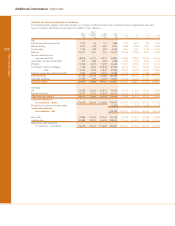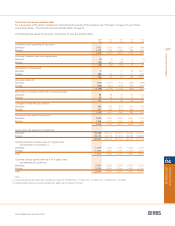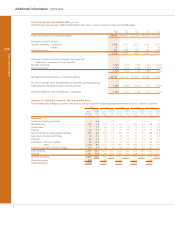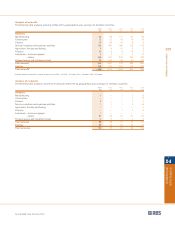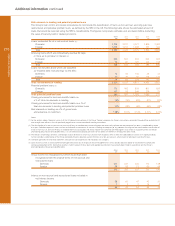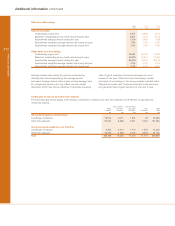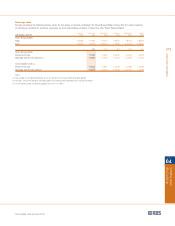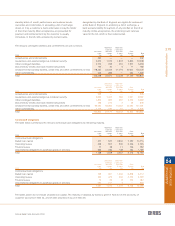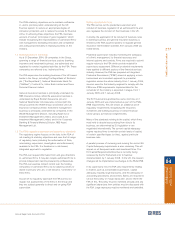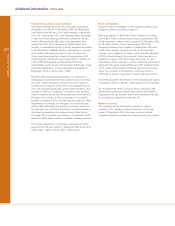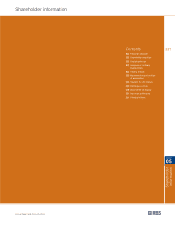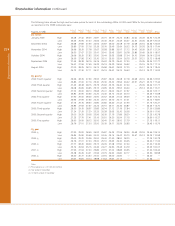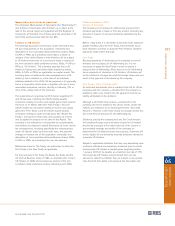RBS 2004 Annual Report Download - page 218
Download and view the complete annual report
Please find page 218 of the 2004 RBS annual report below. You can navigate through the pages in the report by either clicking on the pages listed below, or by using the keyword search tool below to find specific information within the annual report.
216
Additional information
Additional information continued
Economic and monetary environment
Monetary policy
The Group’s earnings are affected by domestic and global
economic conditions. The policies of the UK government, and
of governments in other countries in which the Group operates,
also have an impact.
The UK government sets an inflation target, which changed in
December 2003 from a 2.5% target based on the retail prices
index excluding mortgage interest payments to a 2% target based
on the consumer prices index, in line with other European countries.
The Bank of England has operational independence in setting
the repo rate to achieve the inflation target. The Bank was given
independence by the Chancellor of the Exchequer in 1997, with
the aim of making monetary policy free from political influence,
and therefore more stable and credible. The Bank’s Monetary
Policy Committee ("MPC") meets each month to agree any change
to interest rates, and the minutes of these meetings are
published two weeks later. One-off meetings can also be held
in exceptional circumstances. In response to the downturn in
the global economy and the terrorist attacks, the Bank of
England, along with other major central banks around the world,
cut rates sharply in 2001. Rates remained at exceptionally low
levels throughout 2002, and were reduced again in the first half of
2003, reflecting the uncertain nature of the global and domestic
economic circumstances. However, signs of recovery in the global
economy led the Bank of England to increase rates five times
since November 2003, to 4.75%.
The value of sterling is also important for UK monetary
conditions. The monetary authorities do not have an exchange
rate target, but movements in sterling played a role in the
MPC’s monthly debates.
European Economic and Monetary Union (“EMU”)
The new European single currency, the euro, came into being
on 1 January 1999. The third stage of EMU started on
schedule on 1 January 1999. During the course of 1998, it was
determined that eleven countries (Austria, Belgium, Finland,
France, Germany, Ireland, Italy, Luxembourg, the Netherlands,
Portugal and Spain) would participate. The UK, along with
Denmark, exercised its right to opt out at that stage, and
Sweden also determined not to be part of this first wave.
On 31 December 1998, the European Currency Unit (the
"ECU") was replaced by the euro on the international currency
markets, on a one-for-one basis. The rates for the euro against
other international currencies were based upon the official
closing rates for the ECU. The bilateral rates for the legacy
currencies of the participating states were derived from their
rates within the Exchange Rate Mechanism and the closing
value of the ECU. These rates, between the legacy currencies
and between these currencies and the euro, were fixed as of 1
January 1999. The euro became the formal currency for all
eleven then-participating states.
Euro notes and coins were introduced into circulation on 1
January 2002 in accordance with the Maastricht Treaty, which
required that legacy currency notes and coins be withdrawn by
30 June 2002. Also on 1 January 1999, the European Central
Bank ("ECB") assumed responsibility for the operation of
monetary policy throughout the euro zone. The ECB sets one
short-term interest rate to cover all twelve countries.
The UK government continues to support EMU entry in principle,
but has decided the UK will not adopt the single currency until
it is in the UK’s economic interests, with a positive referendum
vote. The Chancellor of the Exchequer has laid down five key
economic conditions for UK participation. An assessment of
these five tests took place in June 2003, resulting in the
publication of HM Treasury’s assessment, the 18 supporting
EMU studies, and a third outline National Changeover Plan.
While indicating that these five economic tests have yet to be
fully met, the government has set out a programme of economic
reforms and structural assessments necessary to achieve
readiness for entry. The Chancellor made a progress statement
in Budget 2004, at which point he decided not to undertake an
immediate further assessment of the entry tests.
The Group continues to co-operate with the UK government, and
to work within the financial services sector, to develop thinking
and plans regarding a range of practical issues that would arise
if the UK were to decide to enter EMU. In particular, the Group
continues its involvement in discussions as to how a phased
transition could be achieved, in order to minimise cost and risk.
In addition, due attention is being paid to the implications, for
elements of the Group and for customers, of the introduction of
euro notes and coins and the withdrawal of sterling.
Uncertainty continues on the likelihood and timing of the euro
being introduced in the UK. It is not possible to estimate with
any degree of certainty the ultimate cost of making systems
and operations fully compliant. Expenditure in the year ended
31 December 2004 in preparation for the possible introduction
of the euro in the UK was minimal.
Supervision and regulation
1 United Kingdom
1.1 The regulatory regime applying to the
UK financial services industry
The Financial Services and Markets Act 2000 (“FSMA
2000”), containing an integrated legislative framework for
regulating most of the UK financial services industry, came
into force at the end of 2001. This established the
Financial Services Authority (the “FSA”) as the single
statutory regulator responsible for regulating deposit
taking, insurance and investment business in the UK.
Under the FSMA 2000, businesses require the FSA’s
permission to undertake specified types of activities
including entering into and carrying out contracts of
insurance; managing, dealing in or advising on,
investments; accepting deposits; and issuing electronic
money (“regulated activities”). The FSA has published
detailed regulatory requirements contained in a Handbook
of Rules and Guidance.


